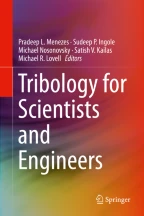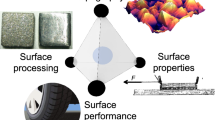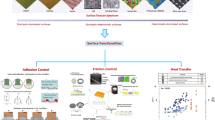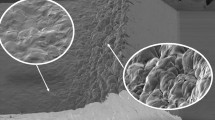Fundamentals of Engineering Surfaces

Understanding engineered surfaces is very important for solving many scientific problems that involve friction, contact mechanics, heat conduction, electric current conduction, and component design. In this chapter, the fundamentals of engineering surfaces and surface texturing are discussed. Various surface layer types are defined, and techniques for generating and characterizing them are presented. Surface roughness measurement techniques to obtain and define roughness parameters using surface profilometry and optical methods are discussed in detail. Surface textures and structures are then classified in terms of various roughness parameters. Finally, experimental results that demonstrate the influence of surface texture on friction are discussed.
This is a preview of subscription content, log in via an institution to check access.
Access this chapter
Subscribe and save
Springer+ Basic
€32.70 /Month
- Get 10 units per month
- Download Article/Chapter or eBook
- 1 Unit = 1 Article or 1 Chapter
- Cancel anytime
Buy Now
Price includes VAT (France)
eBook EUR 287.83 Price includes VAT (France)
Softcover Book EUR 369.24 Price includes VAT (France)
Hardcover Book EUR 369.24 Price includes VAT (France)
Tax calculation will be finalised at checkout
Purchases are for personal use only
Similar content being viewed by others

Surface topography as a material parameter
Article Open access 01 December 2022

Optimizing the surface of manufactured components for friction, adhesion, and convective heat transfer
Article 01 December 2022

How roughness emerges on natural and engineered surfaces
Article 01 December 2022
References
- Buckley DH (1981) Surface effects in adhesion, friction, wear and lubrication. Elsevier, New York Google Scholar
- Bhushan B (2002) Introduction to tribology. Wiley, New York Google Scholar
- Gadelmawla ES, Koura MM, Maksoud TMA, Elewa IM, Soliman HH (2002) Roughness parameters. J Mater Process Technol 123(1):133–145 ArticleGoogle Scholar
- Menezes PL, Kishore, Kailas SV (2006) Effect of directionality of unidirectional grinding marks on friction and transfer layer formation of Mg on steel using inclined scratch test. Mater Sci Eng, A 429(1–2):149–160 ArticleGoogle Scholar
- Whitehouse DJ (1994) Handbook of surface metrology. IOP Publishing Ltd., London Google Scholar
- Feder J (1988) Fractals. Plenum, New York BookGoogle Scholar
- Menezes PL, Kishore, Kailas SV (2006) Influence of surface texture on coefficient of friction and transfer layer formation during sliding of pure magnesium pin on 080 M40 (EN8) steel plate. Wear 261(5–6):578–591 ArticleGoogle Scholar
- Menezes PL, Kishore, Kailas SV (2008) Influence of roughness parameters of harder surface on coefficient of friction and transfer layer formation. Int J Surf Sci Eng 2(1–2):98–119 ArticleGoogle Scholar
- Menezes L, Kishore P, Kailas SV (2006) Studies on friction and transfer layer using inclined scratch. Tribol Int 39(2):175–183 ArticleGoogle Scholar
- Menezes PL, Kishore K, Kailas SV (2006) Studies on friction and transfer layer: role of surface texture. Tribol Lett 24(3):265–273 ArticleGoogle Scholar
- Menezes PL, Kishore, Kailas SV (2008) Effect of surface roughness parameters and surface texture on friction and transfer layer formation in tin-steel tribo-system. J Mater Process Technol 208(1–3):372–382 ArticleGoogle Scholar
- Menezes P, Kishore K, Kailas S (2009) Influence of roughness parameters and surface texture on friction during sliding of pure lead over 080 M40 steel. Int J Adv Manuf Technol 43(7):731–743 ArticleGoogle Scholar
- Menezes PL, Kishore, Kailas SV (2009) Study of friction and transfer layer formation in copper-steel tribo-system: role of surface texture and roughness parameters. Tribol Trans 52(5):611–622 ArticleGoogle Scholar
- Menezes PL, Kishore, Kailas SV (2008) Role of surface texture and roughness parameters in friction and transfer layer formation under dry and lubricated sliding conditions. Int J Mater Res 99:795–807 ArticleGoogle Scholar
- Menezes PL, Kishore, Kailas SV (2008) Studies on friction in an iron-steel tribo-system under dry and lubricated conditions. Mater Manuf Process 23:698–707 ArticleGoogle Scholar
- Menezes PL, Kishore S, Kishore, Kailas SV (2007) Influence of surface texture on friction and transfer layer formation in Mg-8Al alloy/steel tribo-system. Indian J Tribol 2(1):46–54 Google Scholar
- Kumar C, Kishore, Kailas SV (2008) Role of surface texture on friction under boundary lubricated conditions. Tribol Online 3(1):12–18 ArticleGoogle Scholar
- Menezes PL, Kishore, Kailas SV (2008) Effect of surface topography on friction and transfer layer during sliding. Tribol Online 3(1):25–30 ArticleGoogle Scholar
- Menezes PL, Kishore, Kailas SV, Lovell MR (2011) Friction and transfer layer formation in polymer–steel tribo-system: role of surface texture and roughness parameters. Wear 271(9–10):2213–2221 ArticleGoogle Scholar
- Menezes PL, Kishore, Kailas SV, Lovell MR (2010) Response of metals and polymers during sliding: role of surface texture. ASME Conf Proc 2010(44199):267–269 Google Scholar
- Menezes PL, Kishore, Kailas SV, Lovell MR (2011) Studies on friction in steel-aluminum alloy tribo-system: role of surface texture of the softer material. STLE 2011 annual meeting & exhibition, STLE, Atlanta, Georgia, USA Google Scholar
- Menezes PL, Kishore, Kailas SV (2006) Effect of roughness parameter and grinding angle on coefficient of friction when sliding of Al-Mg alloy over EN8 steel. J Tribol 128:697–704 ArticleGoogle Scholar
- Menezes PL, Kishore, Kailas SV (2008) On the effect of surface texture on friction and transfer layer formation—a study using Al and steel pair. Wear 265(11–12):1655–1669 ArticleGoogle Scholar
- Menezes PL, Kishore, Kailas SV (2009) Influence of inclination angle of plate on friction, stick-slip and transfer layer-A study of magnesium pin sliding against steel plate. Wear 267(1–4):476–484 ArticleGoogle Scholar
- Menezes PL, Kishore, Kailas SV, Bobji MS (2010) Influence of tilt angle of plate on friction and transfer layer-A study of aluminium pin sliding against steel plate. Tribol Int 43(5–6):897–905 ArticleGoogle Scholar
- Menezes PL, Kishore, Kailas SV, Lovell MR (2011) Influence of inclination angle and machining direction on friction and transfer layer formation. J Tribol Trans Asme 133(1) Google Scholar
- Menezes PL, Kishore, Kailas SV (2009) Influence of surface texture and roughness parameters on friction and transfer layer formation during sliding of aluminium pin on steel plate. Wear 267(9–10):1534–1549 ArticleGoogle Scholar
- Menezes PL, Kishore, Kailas SV, Lovell MR (2009) Studies on friction and formation of transfer layer in HCP metals. J Tribol Trans Asme 131(3) Google Scholar
- Menezes PL, Kishore, Kailas SV, Lovell MR (2010) Response of materials as a function of grinding angle on friction and transfer layer formation. Int J Adv Manuf Technol 49(5–8):485–495 ArticleGoogle Scholar
- Menezes PL, Kishore, Kailas SV, Lovell MR (2011) Response of materials during sliding on various surface textures. J Mater Eng Perform 20(8):1438–1446 ArticleGoogle Scholar
- Menezes P, Kishore K, Kailas S, Lovell M (2011) Role of surface texture, roughness, and hardness on friction during unidirectional sliding. Tribol Lett 41(1):1–15 ArticleGoogle Scholar
- Menezes PL, Kishore, Kailas SV, Kishore K, Lovell MR (2011) Factors influencing stick-slip motion: effect of hardness, crystal structure and surface texture. ASME Conf Proc 2011(54747):71–73 Google Scholar
- Pottirayil A, Menezes PL, Kailas SV (2010) A parameter characterizing plowing nature of surfaces close to Gaussian. Tribol Int 43(1–2):370–380 ArticleGoogle Scholar
- Menezes PL, Kishore, Kailas SV (2009) Role of surface texture of harder surface on subsurface deformation. Wear 266(1–2):103–109 ArticleGoogle Scholar
- Menezes PL, Kishore, Kailas SV (2008) Subsurface deformation and the role of surface texture—a study with Cu pins and steel plates. Sadhana Acad Proceed Eng Sci Compendex(3):191–201 Google Scholar
- Menezes PL, Kumar K, Kishore, Kailas SV (2009) Influence of friction during forming processes—a study using a numerical simulation technique. Int J Adv Manuf Technol 40(Compendex):1067–1076 ArticleGoogle Scholar
- Menezes PL, Kishore, Kailas SV (2010) Influence of die surface textures during metal forming—a study using experiments and simulation. Mater Manuf Process 25(9):1030–1039 ArticleGoogle Scholar
- Menezes PL, Kishore, Kailas SV, Lovell MR (2012) Analysis of strain rates and microstructural evaluation during metal forming: role of surface texture and friction. Tribol Trans 55(5):582–589 ArticleGoogle Scholar
- Menezes PL, Kishore, Kailas SV (2009) Studies on friction and formation of transfer layer when Al-4Mg alloy pins slid at various numbers of cycles on steel plates of different surface texture. Wear 267(1–4):525–534 ArticleGoogle Scholar
- Menezes PL, Kishore, Kailas SV, Lovell MR (2011) The role of surface texture on friction and transfer layer formation during repeated sliding of Al–4Mg against steel. Wear 271(9–10):1785–1793 ArticleGoogle Scholar
- Menezes PL, Kishore, Kailas SV, Lovell MR (2013) Tribological response of soft materials sliding against hard surface textures at various numbers of cycles. Lubricat Sci 25(2):79–99 Google Scholar
Author information
Authors and Affiliations
- Department of Industrial Engineering, University of Wisconsin-Milwaukee, Milwaukee, WI, 53201, USA Pradeep L. Menezes & Michael R. Lovell
- Department of Mechanical Engineering, Indian Institute of Science, Bangalore, 560 012, India Satish V. Kailas
- Pradeep L. Menezes




